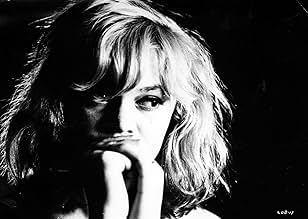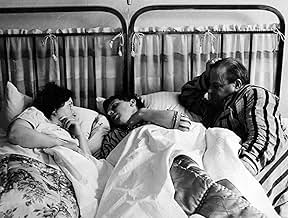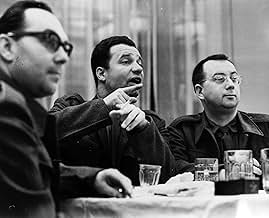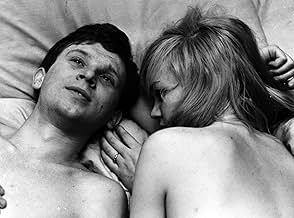NOTE IMDb
7,4/10
9,9 k
MA NOTE
Une jeune femme de la classe ouvrière dans une petite ville tchèque pass la nuit avec l'un des membres d'un groupe de Prague. N'entendant plus parler de lui, elle fait ses bagages et arrive ... Tout lireUne jeune femme de la classe ouvrière dans une petite ville tchèque pass la nuit avec l'un des membres d'un groupe de Prague. N'entendant plus parler de lui, elle fait ses bagages et arrive à sa porte, mettant sa famille dans le pétrin.Une jeune femme de la classe ouvrière dans une petite ville tchèque pass la nuit avec l'un des membres d'un groupe de Prague. N'entendant plus parler de lui, elle fait ses bagages et arrive à sa porte, mettant sa famille dans le pétrin.
- Réalisation
- Scénario
- Casting principal
- Nommé pour 1 Oscar
- 2 victoires et 4 nominations au total
Jana Novaková
- Jana
- (as Jana Nováková)
Jindrich Heidelberg
- Reditel
- (non crédité)
Dana Valtová
- Bohunka
- (non crédité)
Avis à la une
Part of what was known as the Czech New Wave in the 1960s and this particular title a great favourite of Film clubs and societies back in my younger days. Director Milos Foreman, of course, left what is now known as the Czech Republic for the US where he made films as diverse as The People vs Larry Flynt, Amadeus and One Flew Over the Cuckoo's Nest. Before leaving he mad a trio of film in his native country of which this is probably the best although his similar and later film The Firemen's Ball had, perhaps even greater impact internationally being in colour. For A Blonde in Love Foreman uses mostly local people from the village where he shot with, I believe, only one professional actor who it turns out was as influenced by the non actors as there were by him. The young blonde of the title was the sister of the director's wife and gives a wonderful performance. Indeed the whole piece, barely a story, is a joy to watch despite the cringe worthy moments, on the dance floor in particular. A warm and caring film that is beautifully shot and despite an obvious air of austerity throughout still managing to convey a feeling of positivity. Lovely.
This is such an exquisite cinematic weave of feelings, I was taken aback. But only half of it is there, the rest you'll have to supply which is even better in a way. Films come into being after all in that space between what is there and the experience in the eye.
But first. Watch it once straight through because it's funny as hell in that gentle way the Czech know so well, just light and bitter enough to be like getting tipsy on life, delighted at the tipsiness. It's well made and well acted, you can see why Milos Forman was quickly tapped by Hollywood.
Watching it once, you'll have this as your template—a teenage girl's impressionable drift through male sexual whims, and bittersweet realization in the end of heartbreak every time. Now bring all these other things to it:
The guys are only looking to get laid, this isn't about them.
It's a story the blonde girl tells to her girlfriend using the photograph of a boy, both real and imagined. Knowing this, is knowing everything else including the seduction is her exploring by allowing herself to be explored.
The gaffe with the bottle of wine sent by horny soldiers to the wrong table, the ugly ducklings instead of the pretty blonde. But it makes its way to the right one, and we have the two soldiers go after the two girls (but not the blondie), and that subplot abandoned with inviting glances.
Now her seduction (remember, still a story she will tell) but we actually skip sex, and go straight to the intimacy and youthful joking around on the bed which is what she yearns for, connection. And as she leaves the room, she meets the ugly duckling coming back to her room after her parallel night with the soldier.
The lecturing by a teacher on girls guarding a woman's honor, and she boards the first bus out of there. Is she mad? Looking for answers?
The cut from her alone in a country road boarding the bus, to a dance floor in the city filled with young couples, to TV footage of dancing girls in the parents' home. Amazing storytelling, because it is not of the story but the air around the girl lifting her from that road to wait for him in his house.
Her being 'locked' in the house, falling asleep to the mother's incessant nagging. Waking up again, now the boy is there but he's not who she would like him to be—she watches heartbroken through a peephole (a cinematic device) as the pettiness of family life is revealed.
So this is wonderful. It ends with her telling this story better than it is.
I would change a single detail—we'd never be shown who is in either of the two photographs.
It would be about any of these girls dreaming up all we've seen. (we see them all asleep in the end)
Sex safely explored inside the fantasy, and the fantasy both 'real' and imaginary, helter skelter so you wouldn't know where last day's glances end and the pillow book starts. The ugly duckling as the blonde. It can support all that and more, excellent, excellent stuff.
In order to appreciate why this is special, watch another Czech film called Daisies (Sedmikrásky), more inventive on the surface, more irreverent on the same subject, but it doesn't hit deep. It has the images but not the life that gives rise to them, there are both here, and how.
It's so good, it rivals Celine and Julie Go Boating on my list of great films, a similar film on the layered dreaming of a girl.
But first. Watch it once straight through because it's funny as hell in that gentle way the Czech know so well, just light and bitter enough to be like getting tipsy on life, delighted at the tipsiness. It's well made and well acted, you can see why Milos Forman was quickly tapped by Hollywood.
Watching it once, you'll have this as your template—a teenage girl's impressionable drift through male sexual whims, and bittersweet realization in the end of heartbreak every time. Now bring all these other things to it:
The guys are only looking to get laid, this isn't about them.
It's a story the blonde girl tells to her girlfriend using the photograph of a boy, both real and imagined. Knowing this, is knowing everything else including the seduction is her exploring by allowing herself to be explored.
The gaffe with the bottle of wine sent by horny soldiers to the wrong table, the ugly ducklings instead of the pretty blonde. But it makes its way to the right one, and we have the two soldiers go after the two girls (but not the blondie), and that subplot abandoned with inviting glances.
Now her seduction (remember, still a story she will tell) but we actually skip sex, and go straight to the intimacy and youthful joking around on the bed which is what she yearns for, connection. And as she leaves the room, she meets the ugly duckling coming back to her room after her parallel night with the soldier.
The lecturing by a teacher on girls guarding a woman's honor, and she boards the first bus out of there. Is she mad? Looking for answers?
The cut from her alone in a country road boarding the bus, to a dance floor in the city filled with young couples, to TV footage of dancing girls in the parents' home. Amazing storytelling, because it is not of the story but the air around the girl lifting her from that road to wait for him in his house.
Her being 'locked' in the house, falling asleep to the mother's incessant nagging. Waking up again, now the boy is there but he's not who she would like him to be—she watches heartbroken through a peephole (a cinematic device) as the pettiness of family life is revealed.
So this is wonderful. It ends with her telling this story better than it is.
I would change a single detail—we'd never be shown who is in either of the two photographs.
It would be about any of these girls dreaming up all we've seen. (we see them all asleep in the end)
Sex safely explored inside the fantasy, and the fantasy both 'real' and imaginary, helter skelter so you wouldn't know where last day's glances end and the pillow book starts. The ugly duckling as the blonde. It can support all that and more, excellent, excellent stuff.
In order to appreciate why this is special, watch another Czech film called Daisies (Sedmikrásky), more inventive on the surface, more irreverent on the same subject, but it doesn't hit deep. It has the images but not the life that gives rise to them, there are both here, and how.
It's so good, it rivals Celine and Julie Go Boating on my list of great films, a similar film on the layered dreaming of a girl.
Milos Forman's "Loves of a Blonde" which he made in Czechoslovakia in 1965 way before "Cuckoo Nest" and "Amadeus" tells a very simple bitter-sweet tale about a teenaged girl who works in a shoe factory in a small town. With sixteen girls to one man - her chances to find a man of her dreams were not very high. One evening, she meets an attractive and young piano player who tells her about Prague and compares her to a guitar that could've been painted by Picasso. After they spend the night together, he leaves and she travels to Prague to find him. The film has been one of my favorites for many years and my opinion did not change after I saw it again a week ago - funny, sad, tender, and realistic film about searching for love, broken promises, shattered hearts, and universality of hope.
This is the second of Forman's Czech films I've watched after the other Criterion release, THE FIREMAN'S BALL (1967) - though that was via a late-night Italian TV broadcast some years ago; these two films constitute his most celebrated work from this early phase in his career.
While a pleasant and sharply-observed comedy-drama in itself, which must have seemed fresh at the time (particularly the intimate detail of its teenage romance), I feel that a lot of these unassuming but critically-acclaimed foreign films - often made under strained political conditions - tend to come off as overrated when viewed today (a similar recent example I encountered was CLOSELY WATCHED TRAINS [1966]). That said, the film benefits immensely from the wonderful cinematography by Miroslav Ondricek (Forman's longtime collaborator).
Besides, it also includes a couple of lengthy - and delightful - set-pieces: the party sequence, in which the heroine and her two best friends are picked up by a trio of geeky middle-aged soldiers; the scene at the home of the girl's 'boyfriend' (with whom she had a one-night stand), where she causes a commotion by turning up unannounced on his doorstep with a packed suitcase!
The DVD supplements comprise an amusing but irrelevant deleted scene, and an interesting 17-minute interview with Forman - in which he discusses the film's genesis and how the mix of professional and untrained actors proved providential, sealing its essential charm.
While a pleasant and sharply-observed comedy-drama in itself, which must have seemed fresh at the time (particularly the intimate detail of its teenage romance), I feel that a lot of these unassuming but critically-acclaimed foreign films - often made under strained political conditions - tend to come off as overrated when viewed today (a similar recent example I encountered was CLOSELY WATCHED TRAINS [1966]). That said, the film benefits immensely from the wonderful cinematography by Miroslav Ondricek (Forman's longtime collaborator).
Besides, it also includes a couple of lengthy - and delightful - set-pieces: the party sequence, in which the heroine and her two best friends are picked up by a trio of geeky middle-aged soldiers; the scene at the home of the girl's 'boyfriend' (with whom she had a one-night stand), where she causes a commotion by turning up unannounced on his doorstep with a packed suitcase!
The DVD supplements comprise an amusing but irrelevant deleted scene, and an interesting 17-minute interview with Forman - in which he discusses the film's genesis and how the mix of professional and untrained actors proved providential, sealing its essential charm.
It is true but sad that no one in the world would have known about a small Czech town named Zruc if Czech director Milos Forman had not made this film.It is a good thing that he has made it as its fresh appeal would ensure that it is remembered as a supreme example of a famous cinema movement of the sixties called Czech new wave."Lásky jedné Plavovlásky" is a touching film about sad realities, disappointments in love faced by innocent people when they pursue an idle romantic relationship.It is based on a real event which took place in Milos Forman's life when at Prague he saw a beautiful albeit a lost girl roaming in the middle of the night.We see the lives of young people especially young girls who feel bored as there is hardly any male companionship available to them.As this film was made in socialist times we also get to see the attitude of parents belonging to a socialist system.Milos Forman makes his film memorable when he deals with risks which young people take when they fall in live.He conveys that it is not so easy to continue a relationship which has remained frivolous from its inception.Loves of a blonde maintains it serious stance as there is a talk of a serious problem of dwindling male female ratio faced by many European nations.One of the most funny moments of this film include a good social experiment when an army unit is asked to move to Zruc in order to woo its lonely girls.
Le saviez-vous
- AnecdotesDirector/screenwriter Milos Forman got the idea for the movie when he met a young girl with a suitcase in the streets of Prague. Her story was very similar to the one in the film.
- ConnexionsFeatured in Fejezetek a film történetéböl: A cseh új hullám (1990)
Meilleurs choix
Connectez-vous pour évaluer et suivre la liste de favoris afin de recevoir des recommandations personnalisées
- How long is Loves of a Blonde?Alimenté par Alexa
Détails
- Date de sortie
- Pays d’origine
- Langue
- Aussi connu sous le nom de
- Loves of a Blonde
- Lieux de tournage
- Zruc nad Sázavou, République tchèque(formerly Czechoslovakia)
- Sociétés de production
- Voir plus de crédits d'entreprise sur IMDbPro
- Durée1 heure 28 minutes
- Couleur
- Mixage
- Rapport de forme
- 1.37 : 1
Contribuer à cette page
Suggérer une modification ou ajouter du contenu manquant

Lacune principale
What is the German language plot outline for Les amours d'une blonde (1965)?
Répondre

























